

High Population Density Triggers Cultural Explosions. Increasing population density, rather than boosts in human brain power, appears to have catalysed the emergence of modern human behaviour, according to a new study by UCL (University College London) scientists published in the journal Science.

High population density leads to greater exchange of ideas and skills and prevents the loss of new innovations. It is this skill maintenance, combined with a greater probability of useful innovations, that led to modern human behaviour appearing at different times in different parts of the world. In the study, the UCL team found that complex skills learnt across generations can only be maintained when there is a critical level of interaction between people. Stonehenge was monument marking unification of Britain. After 10 years of archaeological investigations, researchers have concluded that Stonehenge was built as a monument to unify the peoples of Britain, after a long period of conflict and regional difference between eastern and western Britain.
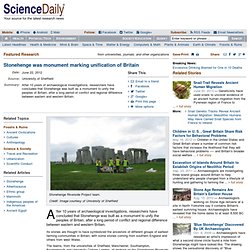
Its stones are thought to have symbolized the ancestors of different groups of earliest farming communities in Britain, with some stones coming from southern England and others from west Wales. Early humans living in villages 400,000 years ago? - SciGuy. Our conventional understanding of human history is that modern humans — Homo sapiens — first began living in communities about 10,000 years ago, settling into a settled life of agriculture, and moving away from hunting, gathering and roving.
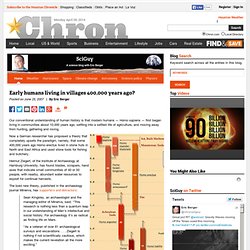
Now a German researcher has proposed a theory that completely upsets the paradigm, namely, that some 400,000 years ago Homo erectus lived in stone huts in North and East Africa and used stone tools for fishing and butchery. AEvidence of Ancient Farming in Iran Discovered. Agriculture may have arisen simultaneously in many places throughout the Fertile Crescent, new research suggests.
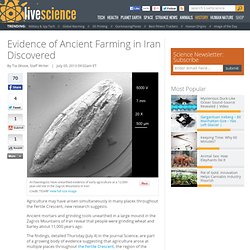
Ancient mortars and grinding tools unearthed in a large mound in the Zagros Mountains of Iran reveal that people were grinding wheat and barley about 11,000 years ago. The findings, detailed Thursday (July 4) in the journal Science, are part of a growing body of evidence suggesting that agriculture arose at multiple places throughout the Fertile Crescent, the region of the Middle East believed to be the cradle of civilization. [In Photos: Treasures of Mesopotamia] "The thing that's most astounding is that it extends the Fertile Crescent much farther east for the early agricultural sites, which are dated to 11,500 to 11,000 years ago," said George Willcox, an archaeologist at the CNRS (National Center for Scientific Research) in France, who was not involved in the study. Beer Domesticated Man - Issue 8: Home. The domestication of wild grains has played a major role in human evolution, facilitating the transition from a hunter-gatherer lifestyle to one based on agriculture.
You might think that the grains were used for bread, which today represents a basic staple. But some scientists argue that it wasn’t bread that motivated our ancestors to start grain farming. It was beer. Man, they say, chose pints over pastry. Beer has plenty to recommend it over bread. In fact, McGovern has found that the ancients used beer as medicine.
Beer also played an important societal role in bonding early communities together. The beer thesis is not universally accepted, however, and the debate over its truth goes back to the 1950s. Beer was thought to be a necessary component in the afterlife. The great advantage of grain is that it didn’t spoil like fruit or berries, and could be kept for months and used as needed. Braidwood believed Natufians used the grain as food, and not for fermentation. Arkaim: Russia’s Ancient City & the Arctic Origin of Civilisation. By VICTORIA LEPAGE Vast shadowy forces are moving in Central Asia – or rather in the greater region we call Eurasia – which may change the face of our global society and civilisation forever.
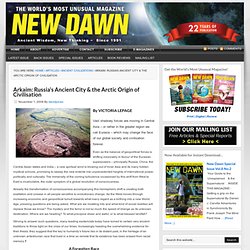
Even as the balance of geopolitical forces is shifting inexorably in favour of the Eurasian superpowers – principally Russia, China, the Central Asian states and India – a new spiritual wind is blowing out of Inner Asia and its many hidden mystical schools, promising to sweep the new entente into unprecedented heights of international power, politically and culturally. The immensity of the coming turbulence occasioned by this shift from West to East is incalculable, the outer symptom of a global revolution of consciousness. Already the transformation of consciousness accompanying this hemispheric shift is creating both exaltation and unease in all people sensitive to evolutionary change. A Forgotten Race Arkaim: A Bronze Age Town in the Southern Urals.
Amazing Metropolis Discovered in Africa is 200,000 years old! By Dan Eden for viewzone.
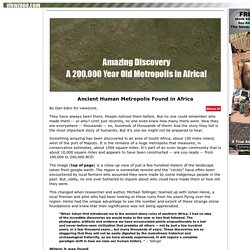
They have always been there. People noticed them before. But no one could remember who made them -- or why? Until just recently, no one even knew how many there were. Two 6,000-Year-Old Buildings Unearthed in England. British archaeologists have unearthed an unprecedented find on Dorstone Hill, near Peterchurch in Herefordshire, England – two large 6,000-year-old halls, each buried within a prehistoric burial mound.
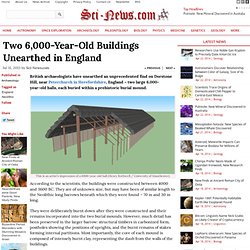
This is an artist’s impression of a 6000-year-old hall (Henry Rothwell / University of Manchester) According to the scientists, the buildings were constructed between 4000 and 3600 BC. They are of unknown size, but may have been of similar length to the Neolithic long barrows beneath which they were found – 70 m and 30 m long.
They were deliberately burnt down after they were constructed and their remains incorporated into the two burial mounds.